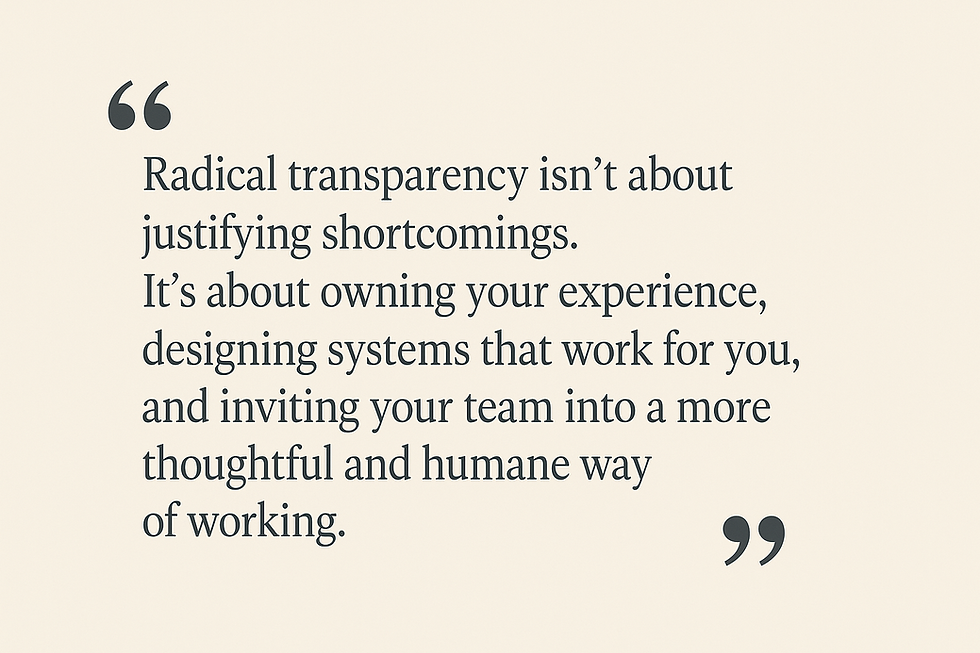ADHD and the 9-to-5: How I Make It Work (Most Days)
- Timothy Gallant
- Jul 11
- 3 min read

If you’ve ever looked at a spreadsheet, calendar notification, or blinking cursor and thought, “I should be doing something right now, but I can’t remember what...,” you’re not alone.
I’ve lived most of my adult life with ADHD. And for much of it, I believed the traditional 9-to-5 structure just wasn’t built for me. But here's the twist: I've found ways to make it work. Not flawlessly. Not effortlessly. But workably. Most days, anyway.
This isn’t a how-to guide. It’s a field report.
Structure Is a Lifeline, Not a Limitation
Before I learned to build structure, I was chasing every fire and forgetting every priority. Now? My calendar is my boss. My tasks live in OneNote and Notion. I’ve built workflows that take the thinking out of the process, so I can focus on the doing.
I use recurring calendar events like “Email Cleanup,” “Check Renewal Queue,” or even “Water the Plants.” It might seem rigid, but the truth is: structure gives me freedom. Because when I’m untethered, I float off into the ether.
Tools I Use (and Actually Stick With)
Time-blocked calendar: My day starts with 3 hours of “deep work” blocked off—no calls, no Slack, no chaos. If I don’t guard my mornings, I lose them to reactive tasks.
Pomodoro timer (25/5 method): I use this when I’m stuck in analysis paralysis. Set the timer, pick one thing, and move.
The 2-Minute Rule: If it takes under two minutes (replying to an email, forwarding a document, scheduling a call), I do it immediately.
Noise-canceling headphones + ambient sound: It’s my version of a sensory straightjacket—and it works.
The ADHD Spiral Is Real
Some days, it all clicks. Others? I’ll toggle between five open tabs, write half of three emails, reorganize a drawer, and suddenly it’s 2:47 PM and I’ve done nothing meaningful.
Here’s what I’ve learned: instead of judging myself for those moments, I’ve started observing them. I’ll literally write down: “Fell into a loop between tasks at 11:12. Felt foggy. Listened to lo-fi beats. Got back on track by 11:47.”
ADHD isn’t a productivity killer—it’s a pattern disruptor. The more I understand my patterns, the faster I can recover when the wheels come off.
Communication Is My Superpower
ADHD has made me highly aware of time, even if I’m not great at managing it. I’ve learned to over-communicate with my team and clients:
“I’ll get that to you by 3 PM.”
“I missed that—completely my fault. Here’s how I’ll fix it.”
“Can we regroup? I’m not tracking what the priority is here.”
People respect honesty. And they really respect follow-through. ADHD doesn’t give me a pass—but it does make me laser-focused on accountability.
Why It Matters
I used to think I needed to fix my brain. Now, I just need to support it.
The 9-to-5 world doesn’t flex easily for neurodivergent minds, but that doesn’t mean we can’t thrive in it. I’ve built workarounds, automations, checklists, and rituals not because I’m disorganized—but because I’m committed.
I don’t always get it right. But I keep showing up. And most days, that’s more than enough.
PS: If you're navigating your own ADHD in a traditional work environment, I'm rooting for you. And if you're leading someone who is, lean in with curiosity, not judgment. There’s more brilliance there than you might see at first glance.




Comments